In this post, I shall outline why featured snippets are important, how to find your current featured snippets and how to maximise your website traffic by gaining new ones.
Google’s mission statement is: “To organise the world’s information and make it universally accessible and useful”. Featured snippets are one way that Google is doing this, to create dynamic and engaging search results for users. They aim to answer a user’s question straight away without the need to click through to another URL.
Here is an example of a featured snippet for the search phrase “loss assessors” that includes Harris Balcombe‘s explanation appearing right in the search results without the user having to click through on any links:

We can see that content from Harris Balcombe’s site appears above organic results to help define the term “loss assessors”. We have outlined the different types of featured snippets and how to optimise your pages for them here.
Why are featured snippets important?
Featured snippets have many advantages, including:
- Take position #0: Your content automatically takes priority over all organic search results. This has given featured snippets their nickname, position #0.
- Increase potential organic traffic: By appearing in multiple featured snippets, you are increasing your chances of appearing higher up in the SERPs for multiple keywords, therefore increasing your organic traffic.
- Trust signals for your brand: As a featured snippet is chosen by Google, your brand will be viewed as reliable, trustworthy and you may see a conversion increase in the future from this.
- Visibility: Being at the top of the SERPs and taking up a large amount of it, a featured snippet draws a user’s eyes to the search result.
- Voice search: Comscore predicts that 50% of all searches will be voice searches by 2020. Google Assistant and Google Home both read out featured snippets, most likely before any organic results. Optimising your pages so you appear in featured snippets will put you in great shape for the voice search revolution. If you want further information on this topic, check out Hallam’s guide to optimising for voice search.
Let’s take a look at an example of when featured snippets have helped drive organic traffic to a website.
One of our clients British Gypsum have an extensive list of FAQ pages to answer customer queries. If we use a popular page as an example – Can I plaster straight onto a painted wall?
The keywords that this page owns the featured snippet for are:
- Can you plaster over paint
- Plastering over paint
- Can I plaster over paint
- Can you skim over paint
- Can you plaster over painted walls
Now if we look at the impact these featured snippets have on their page analytics on Google Analytics:

Here we can see that the number of page views has increased steadily and remained constant since the page was launched. For a simple FAQ page, it has a total of 10,000 page views. Being chosen by Google for 6 feature snippets shows here that it drives organic traffic to your website. By appearing in multiple featured snippets, you can increase your organic traffic potential.
Now we’ve outlined why featured snippets are important, how do we go about finding them? And how can we maximise the number of feature snippets we have to help drive traffic to our website?
How to find your current featured snippets
Understanding what featured snippets you currently appear in is a good place to start before trying to expand your range. You can find your current portfolio easily using multiple tools. I’ll outline my two favourites here and you can decide which one makes more sense for you to use.
SEMrush
One of the most powerful and popular pieces of software in the digital marketer’s toolkit, it is no surprise that SEMrush has a featured snippets identification tool.
For the ability to use this tool on your site, you will need to have position tracking set up. SEMrush has some great how-to guides in their Knowledge Base – a full walkthrough on how to set up position tracking can be found here.
Once you have position tracking sorted, click on your account and find the “Featured Snippets” tab.
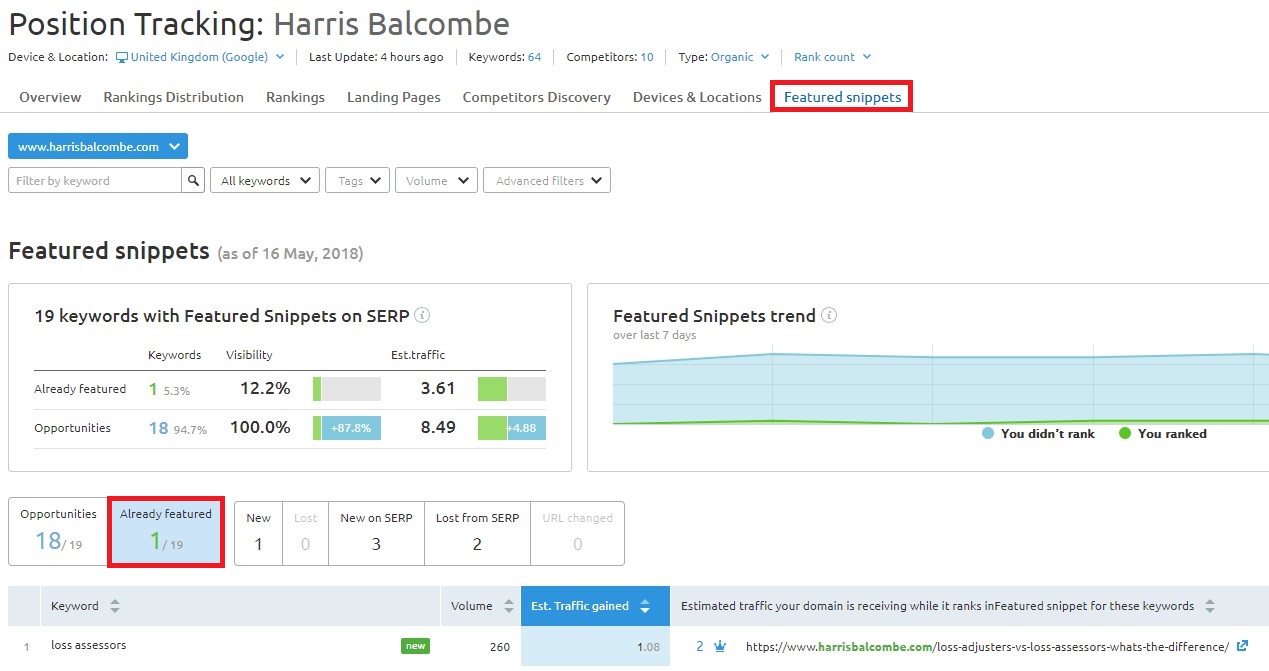
Here, we can see all the featured snippets your site is currently included in, the search volume, estimated traffic gained from this featured snippet and the URL that owns the snippet.
Ahrefs
Ahrefs offers a similar service to SEMrush and is slightly easier to use because it does not require the position tracking set up. Simply enter the domain you wish to analyse and navigate your way to “Organic Keywords”.
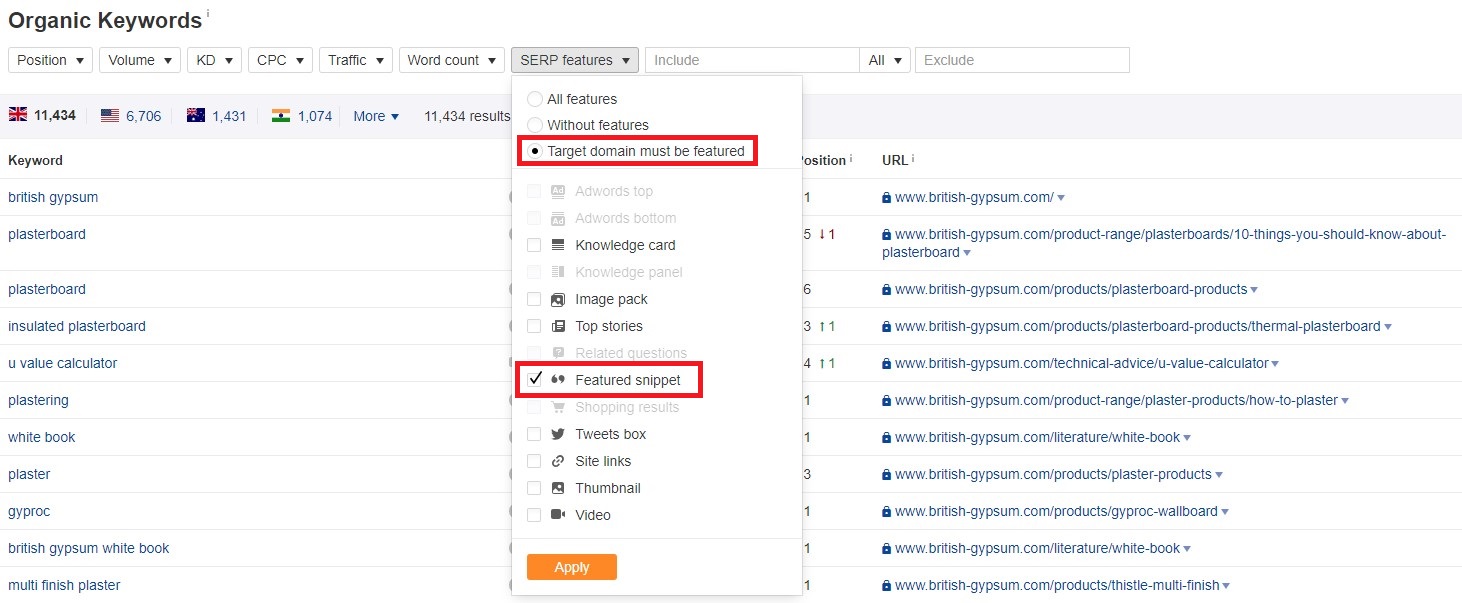
Filter your parameters to “Target Domain Must Be Featured” and “Featured Snippets”. This will bring up all the search queries you where you already own the snippet. See here:

Finding and analysing the featured snippets you currently rank for is important for many reasons, including:
- Understanding what you have been doing correctly to gain a featured snippet
- Auditing them – featured snippets can often be pulled through incorrectly from Google, with formatting an issue
- Understanding where they can be improved to appear in other search queries
How to find potential featured snippets
Once you understand your current featured snippets profile, you can look at acquiring new ones to help improve boost your organic visibility and improve website traffic.
SEMrush
SEMrush shows the opportunities for your site neatly in the same table that indicates your current snippets.
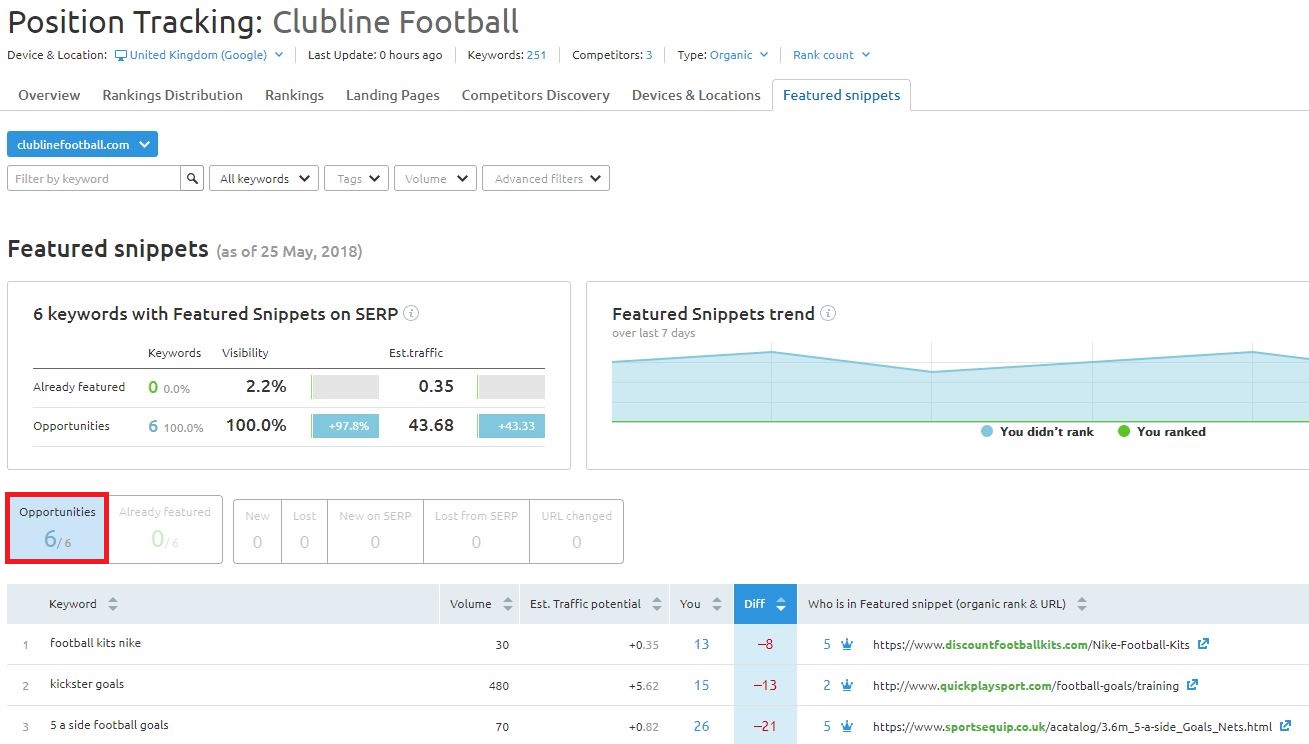
The table above highlights some important metrics surrounding featured snippets. These include search volume, estimated % traffic potential to be gained, your current ranking for the keyword, the current URL that owns the featured snippet and their keyword ranking.
According to a study by Ahrefs in which they analysed two million featured snippets, sites that own the snippets almost always were ranking in the top 10 for the keyword. And the higher your keyword ranking is, the more likely you were to be featured.
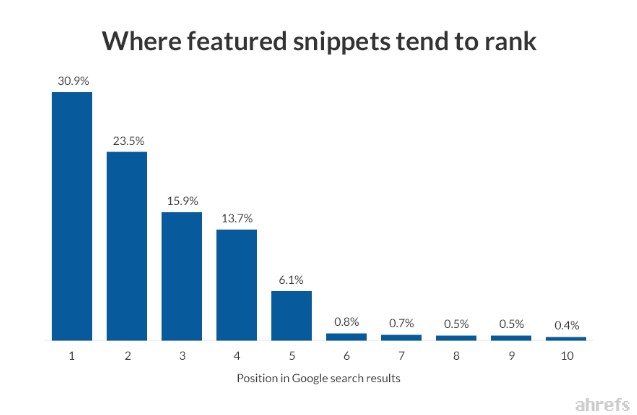
Therefore, by using these statistics, you can look at which keywords you are currently ranking higher than your competitors for, but do not own the featured snippets. Starting with these and making tweaks to your landing pages should be easy wins.
Ahrefs
Ahrefs has this feature which is easy to use: simply follow the same steps you did when finding your current featured snippets. However, instead of ticking “Target Domain Must Be Featured”, select “All Features”. To filter your data further, select the minimum position for your keyword at ten or lower. This will give you a list of keywords that you currently rank highly for, outlining realistic featured snippet targets; ultimately saving you time and money.
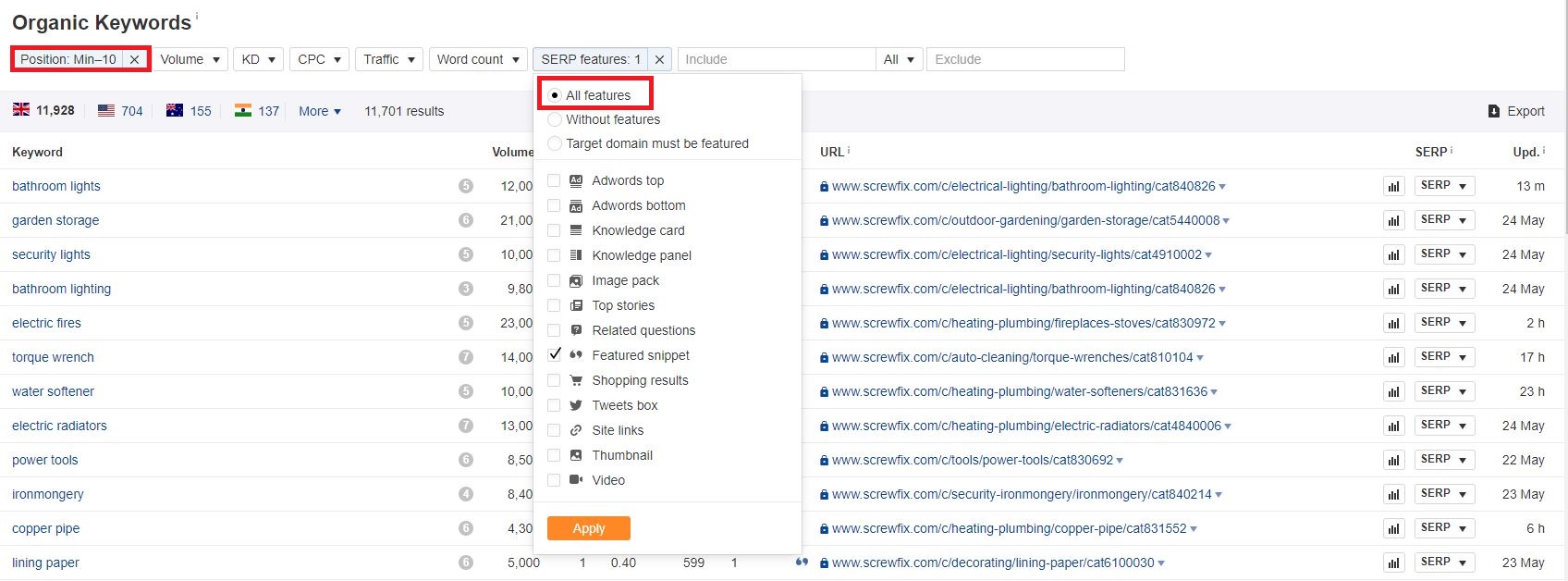
Before manually inputting the keywords into the search bar, try sorting your data by keyword, current position, keyword volume and difficulty. This will help you to segment the data, making it easier to digest and find the keywords with the most opportunity. Aim for keywords with a high search volume that you rank highly for and see if you currently hold the featured snippet. If you do not, then these are the keywords you should be targeting.
Reverse engineering
Alternatively, you can use the same steps you used to find your current featured snippets and enter your competitor’s details to pull through all the featured snippets they own. Then you can sort by keyword volume or difficulty and check how secure each featured snippet they own is. Discover if they own a featured snippet relevant to your business with a high search volume. These are further opportunities to improve your featured snippets profile, improve your content appropriately and you should see some results.
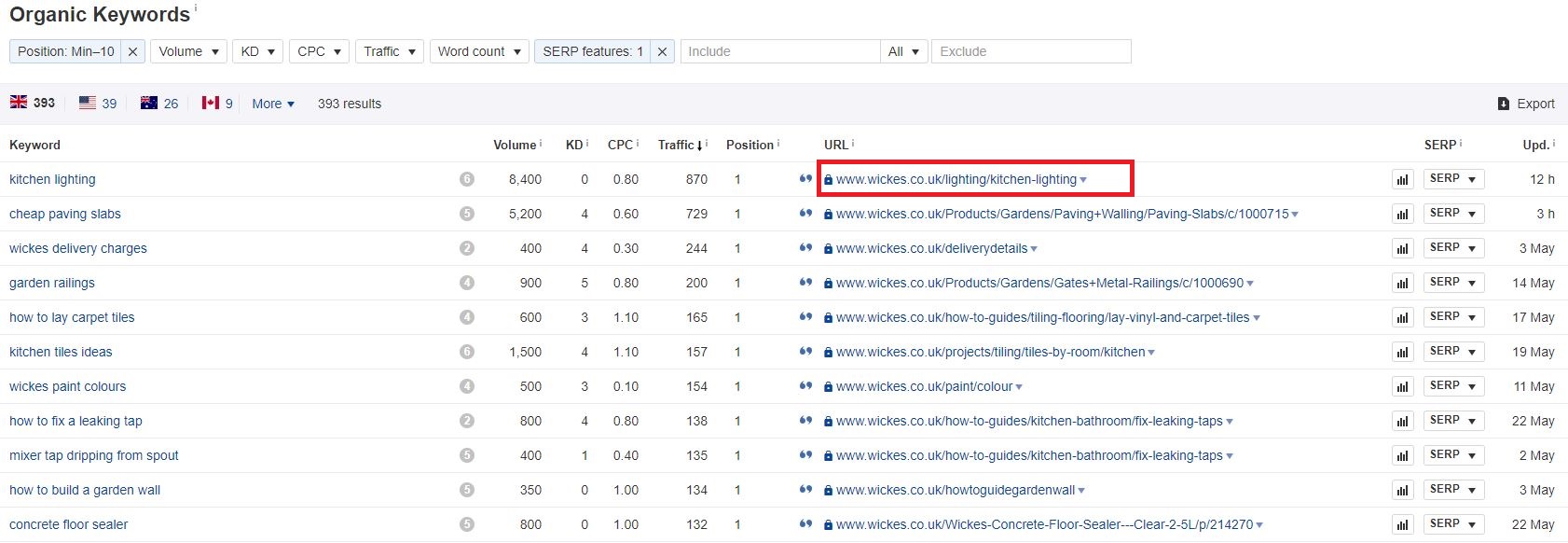
Don’t forget!
Whilst these tools will help you to find specific featured snippets, it is still very important for you to carry out content gap analysis. Use tools like Buzzumo’s Question Analyser and Answer The Public to see what long-tail keywords are highly searched for in your industry. If you have a customer service desk, ask for data on the most frequently asked questions. Remember, the majority of featured snippets are answering questions; therefore, by understanding what questions are most frequently being asked around your keywords, you can best optimise and appear in featured snippet results.
The future of featured snippets?
Google is constantly looking to update and improve the user experience, so it’s no surprise that featured snippets are expected to change too. This month, studies have shown that Google is currently testing removing organic results displayed in the featured snippets. This is to stop websites from double-dipping with organic visibility so one site does not appear in the featured snippet (position #0) in addition to position #1.
Final thoughts
The featured snippet landscape may be competitive, but it is something you should be considering as part of your overall digital marketing strategy. The exponential rise of voice search and people’s desire for fast and simple information means appearing in snippets will only become more relevant. Understanding your current featured snippet profile has never been easier, as has understanding your competitors’. If you’re looking to improve your website traffic, give these techniques a try and see how many featured snippets you can acquire. Alternatively, for help with your SEO strategy, get in touch with us today.


